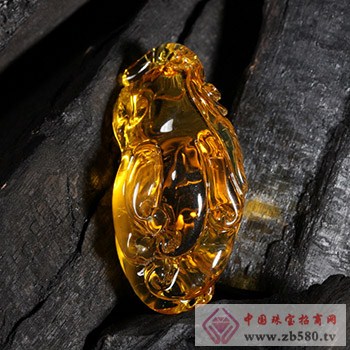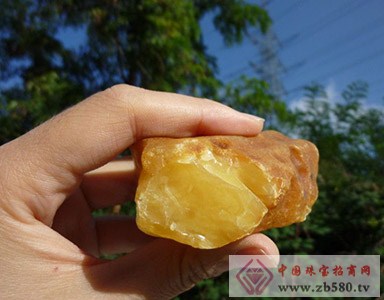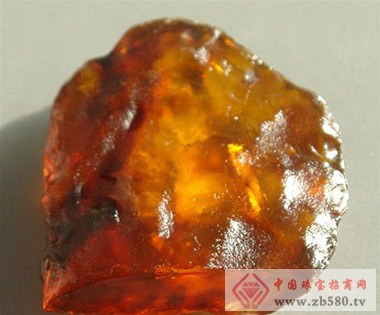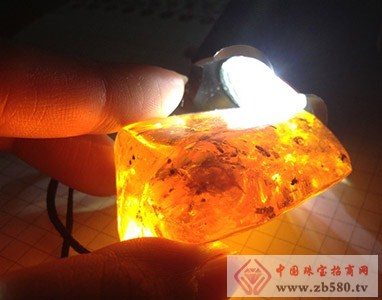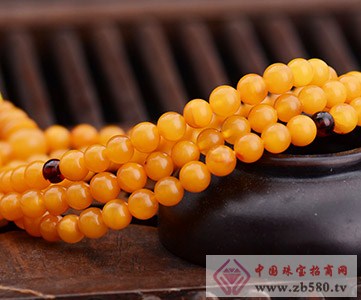Amber, there is no gold and silver luxury, no dazzling light of diamonds, but not arrogant, just quietly set off the wearer's implicit taste and cultivation. Amber, mostly produced in Poland, Ukraine, Lithuania, Russia and other coastal countries of the Baltic Sea, the amber produced in these countries, the color is golden and transparent, the texture is crystal clear, the quality is good, and the size is big. The output is about 80% to 90% of the world's market. The amber that is generally seen in shopping malls is mostly the amber of these Baltic. Baltic Amber Introduction 1 Baltic Amber Introduction Located in the western part of Eastern Europe, bordering on the Baltic Sea, Lithuania is beautiful and quiet. On this land of less than 70,000 square kilometers, the Lithuanians who are kind and peace-loving have lived for thousands of years. In Lithuania, many posters and brochures can be seen in the mouth of a dinosaur with a crystal clear yellow amber. This yellow amber is the famous Baltic amber. Initially, the word amber was specifically referred to as the Baltic amber. The amber of the Baltic Sea accounts for 90% of the world's total amber production and is known for its precious content, because these connotations are primitive creatures tens of millions of years ago, many of which have long since disappeared from the earth. In the amber's connotation, the most common "captive" is the spider in the forest. When you look at the small animals that came from millions of years ago, you will have to feel the magic of nature, and you will be unconsciously A little amber attracts. Baltic amber is not only a symbol of time, but its color is orange and transparent. The color changes when it is close to the fire. It is very strange. After the craftsman's fine craftsmanship, there is a perfect, smooth and round amber product. Because of the characteristics of amber that has not changed its true color after thousands of years, it is regarded as a symbol of love. 2 Baltic amber price The Baltic coast is the world's leading amber producer. The amber quality here is known as the “Baltic Goldâ€. Among them, Poland is the earliest mining and utilization amber, and the most successful country for the commercial operation of amber. In recent years, due to rising market demand and the control of amber mining and exports in some producing countries, Poland's amber price has risen year after year, rising about 10 times in five years. The value and popularity of “Baltic Gold†has surpassed the real gold. The history of human use of amber has a long history and can be traced back to the Roman era. Amber is not only a favorite ornament, but also a religious sacred object in many countries. Baltic amber is distributed in Denmark, Germany, Poland, Lithuania, Latvia, Russia's Kaliningrad region, Sweden and Ukraine on the Baltic coast. The world's largest amber deposit is located in the Kaliningrad region of Russia. Because of the value of amber, as early as 3500 BC, the Baltic amber became a commodity that was shipped to Greece and the Mediterranean Sea and cities along the Black Sea. In 1600 BC, residents of the Baltic coast also used amber as a currency. From the 1st to the 3rd century AD, the area formed the "Amber Road" for the amber trade in the Roman Empire and other places, and became the channel for the exchange of ancient civilizations. In Rome, the “Amber Road†was also connected to the “Silk Roadâ€, forming a route to transport amber to China. Today, the value of amber is more recognized and its price has risen year after year. According to the International Amber Association in Poland, in the last five years, the price of amber has risen from 1,000 PLN per kilogram (about US$323) to the current 10,000 PLN (about US$3,226). The international president of the Amber Association, Kosher, said that the price of Baltic amber depends on the amount of Russian amber exports and the amount of amber in Poland. In recent years, there have been three main reasons why amber prices have surpassed gold. First, the amber exporting country Russia has increased its control over the export of amber raw materials since last year. The largest amber export in the Kaliningrad region has also been completely terminated last year. This has greatly affected the supply of amber rough. According to data from the International Amber Association, the amount of amber that has entered Poland from the Kaliningrad region has been around 300 tons per year due to insufficient amber extraction in Poland and Lithuania. Second, European jewellery designers and amber jewelers' interest in amber has continued unabated over the years. According to the statistics of the International Amber Association, in Poland alone, the output value of the jewelry industry including amber in 2010 reached about 200 million euros. Third, the emergence of new purchasing power is also an important reason for stimulating the price of amber. Koshoor said that most of the Baltic amber was exported to Europe and the United States. In recent years, more and more merchants from China and Arab countries have purchased amber raw materials and accessories, which has become a new purchasing power for the amber market. 3 Baltic amber origin It is the world's most famous amber producing area, and the amber produced is one of the best in terms of quantity and quality. The amber produced on the Baltic coast is also the only source of Haiper, which is very special. There are many countries on the Baltic coast, the most famous of which are made in Poland, Lithuania and Russia. Because of the high transparency of the Baltic amber, it is easy to observe and contains a lot of wrap. Their age is about 30 million to 60 million years, from the early Eocene - late Oligocene. They are many of the "BlueEarth" that protrude into the blue mud in the Baltic Sea, which is lower than the water table. After the storm, they are caught in the sea and rushed to the shore. The largest mineral in the Baltic Sea is located in Kaliningrad, Russia. Kaliningrad borders Poland and Lithuania. It is a state that has separated from the Russian mainland. It was once the territory of Prussia. It was renamed Kaliningrad after being classified in Russia. The Baltic amber is extremely rich in color. It is usually lemon yellow and orange when it is mined, and it has a cloud (bean wax) and is also transparent. The transparent amber can clearly see the insects and other wraps, and the beeswax can't see the inside because it is opaque, except for the bark grass roots floating on the surface. Typically exposed to air or sea water for at least 50 years, the amber surface is oxidized to dark orange and red. The vast majority of Baltic amber contains succinic acid that is good for the human body, so the Baltic amber is also known as succinite (succinic acid). 4 Baltic amber production Baltic amber is a subspecies of amber that exists only in the Nordic region and accounts for 80% of the world's total amber production. Most Baltic amber is made from turpentine between 35 and 50 million years ago. At that time, the temperature on the land rose sharply, and the heat caused the pine trees in the forests along the Baltic Sea to secrete thick turpentine. Later, as the geological changes, large areas of forest sank into the seabed, and after a long geological evolution, the sediment after the rosin hardened became amber. Amber is often washed out by seawater from the seabed, and it is like a sinking and sinking state in salty seawater. It is often drifted to coastal countries such as the United Kingdom, the Netherlands, Poland, Germany, and Russia by ocean currents and monsoons. Picking up amber at the seaside after the storm. However, about 90% of the world's steable amber is still located in the Kaliningrad region of Russia (known as Königsberg in Germany, and classified as Russia after World War II), which is also the largest in the world. Amber production site. 5 Baltic amber true and false identification Most of the amber sold on the market is Baltic amber, which is the largest amber variety in the market today. Many people think that most of the Baltic amber is optimized, which is not natural amber. In fact, the number of natural Baltic amber is not small. The key is how to distinguish it. It is undeniable that there are many optimizations in the market. Baltic amber is the first to bear the brunt. Who knows that this amber production is the biggest? It will easily cause the Baltic amber to optimize the phenomenon. So what is the identification method of natural Baltic amber? The main feature of the Baltic amber is that it contains scales, a glistening, colorful interior texture. This scale texture is not unique to the Baltic amber, but only the Baltic amber has a gorgeous and vivid scale texture. In the identification, it is important to see whether there is a beautiful high-profile and varied scale texture. Those optimized have similar scales, but during the heating process, the scales change, like bursting, and their shape is similar to that of the lotus leaf. Compared to natural scales, these scales are more open and higher-profile. Coba resin is also easily confused, but it is significantly different from natural Baltic amber. It has no obvious scale texture inside, and only a large number of bubbles exist. 6 Baltic Amber Classification The world's amber is widely distributed, and the Baltic amber is famous, and the quality of natural amber produced on the southern shore of the Baltic Sea is considered to be the best. In addition, the world famous Amber City Gdansk is also here. Due to the special geological, historical and climatic conditions, the Baltic Sea produces a wide variety of amber varieties, which are transparent, translucent and opaque; the colors are also very large, yellow, red, brown, white, blue, green and so on. There are two main types of output in the Baltic amber: (1) Haiper: This natural amber is produced in the sea and can float on the water. The locals call it “sea stoneâ€. The amber-bearing formation in the sea or near the sea is washed away by sea water, and amber can also be washed out, while the beach is still floating a lot of artificially mined amber raw materials. (2) Hangper: This type of amber is harvested from mines near the Baltic coast and is similar in quality to the amber raw material produced in the Baltic Sea. According to the investigation, the amber ore-bearing layer on the Baltic coast is an undiagenetic peat layer with a thickness of 4-5 meters and a thickness of more than ten meters. Amber is layered and lumpy, and the upper part of the ore-bearing layer is looser. Local mining is generally open or pit mining. Excavate along the amber-bearing deposit. Due to the convenience of mining, a worker can pick up to hundreds of kilograms of raw materials per day during the early years. Shorts And Pants,Short Pants For Men,Men's Shorts And Pants,Short Trousers For Men Shaoxing Chunsen Textile Co.,Ltd , https://www.chunsentextile.com